For more information:
Note that the latest stuff may not yet be indexed.
The Klezmer Shack directory of articles
As part of a resolution I made last fall, I apologize for the order. Years of adding, falling, restacking, have rendered everything pretty confused. I am going through the stacks and stacks of Klezmer music CDs and trying to get the word out about as many as possible. These may not be the full reviews I used to enjoy dedicating to each album, but if the choice lies between getting the work out about good music, or awaiting the moment to do a full review, let's just get the word out!
 Klezmokum / ReJew-venation, BV Haast CD
9809, 1998.
Klezmokum / ReJew-venation, BV Haast CD
9809, 1998.
This came out at the end of 1998, during a period when I was moving around a lot. So, the CD has moved around a lot with me. As was true of the first two Klezmokum CDs (see my review of the eponymous, first CD), this Dutch band fuses some very delightful jazz with klezmer and other Jewish and Israeli music influences. Bandleader Greene has deliberately delved into less-well-known repertoire. The result is something jazzy, Jewish, and quite relaxing on the ears. At the same time, the band explores a wider diversity of music than I usually hear. On this outing, compositions range from a Russian Sher to John Zorn, with Sephardic and Israeli dances in between. Patricia Beysens' occasional vocals are a delight, as on the (new to me) "El Rey Por Muncha Madruga". The band is the only (?) foreign band to appear each year at the Knitting Factory's week-long avant garde Jewish music festival (held each year, like KlezCamp, to overlap that popular December commercial holiday). [GRADE: A]
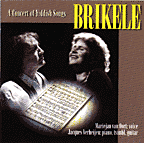 van Oort & Verheijen / Brikele: A concert of Yiddish Songs, Suncoop 5757 CD 207, 1997.
van Oort & Verheijen / Brikele: A concert of Yiddish Songs, Suncoop 5757 CD 207, 1997.
When this album came out, a friend e-mailed from Austria to be on the lookout for something extraordinary. A friend in Brooklyn asked if I was going to do my usual ignorant job of reviewing Yiddish song, and didn't this deserve better? Thus intimidated I have done the worst possible: I have failed to tell the world about this extraordinary program of Yiddish art song. A couple of months ago I found time to review (in a timely fashion, at least, the latest production by this duo, Benkshaft. This is the album that set the incredibly high standard that Benkshaft was forced to meet or equal (it did). There is a grace and beauty to van Oort's voice, and an understated perfection to Verheijen's accompaniment as accompanied by a version of "Huljet huljet, kinderlekh" that transforms the song from the everyday kids calling to something that brings a special quiet. I may have been intimidated about writing about this album, but I have never hesitated to listen to it often. [GRADE: A+]
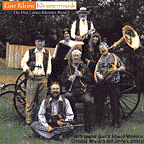 The Hot Latkes Klezmer Band / Eine Kleine Klezmermuzik
The Hot Latkes Klezmer Band / Eine Kleine Klezmermuzik
There I am at KlezKanada. A very nice person with a viola strides up with a latest release by his band. They play the usual klezmer repertoire, and as I discover over the next few months, do it extraordinarily well. But there is also this string thing--points, where they break into a sort of classical ensemble bit, as on the terrific opening suite from this particular album, "Eine Kleine Klezmermuzik" with its "Ludwig van Bulgar" and "Shmalzando". Although the band is not above repeating chestnuts such as "Cuando el Rey Nimrod," at least they do it with originality and musicianship such that one is halfway through the song before remembering that one should never enjoy such overperformed clichés, well, maybe just this once. I even forgive them for recording the klezmer song I need least to hear ever again, "Ot Azoi." I should also note that since Jonno hasn't gotten around to recording his own Toronto-based band yet, this recording is the only recording, of which I am aware, to feature Toronto's major mensh and clarinet player, Jonno Lightstone.. [GRADE: A]
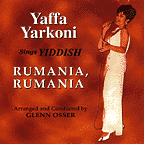 Yaffa Yarkoni / Rumania, Rumania
Yaffa Yarkoni / Rumania, Rumania
Listening to young Israel's premier singer, she with the last name of the river that flows through the first Jewish-founded city in modern times, singing "Beautiful as the moon" ("Shein vi di levone") with her modern Israeli accent sometimes competing with more familiar Yiddish inflections, is a trip back in time. Recorded originally during the 1960s, the album is primarily Yiddish standards, with just a few of the new Israeli songs: "Heveinu Sholem Aleichem" or "David Melech Israel" that made her famous creeping in. Yarkoni's dusky voice is in fine form, and the arrangements are very much typical of their time--things I associate with early Israeli work by Shoshana Damari, the slightly younger Esther Ofarim. To Americans they also remind us of the television music arrangements of the time. For people who remember the voices and optimism of that time, this album is a glorious rerelease. Those of us who came later will find it old-fashioned. Such is the callowness of youth. Simon Rutberg, of Hatikvah Music (www.hatikvahmusic.com) is to be commended for making this long unavailable album available on CD for the first time.
. [GRADE: B]
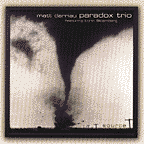 Matt Darriau and The Paradox Trio / Source, JAM/KFR 237
Matt Darriau and The Paradox Trio / Source, JAM/KFR 237
I am a big fan of the Paradox Trio, Matt Darriau's quartet that blends avant gardeish jazz with balkan and klezmer sources. Darriau plays clarinet, saxes, and kaval. I readily confess that this is exactly the sort of music that I consider comfort music, and this band plays it very well. Here, Matt's fellow Klezmatic, Lorin Sklamberg offers some vocals, too. North African music maven Brad Shepik adds a lot of rhythms from the other side of the Mediterranean, and contributes some delightful guitar work. If I have any complaint, it is that these guys have become too nice. The album lacks dissonance. (I readily acknowledge that this would be a benefit to 95% of the listening public!) I think that Michael Alpert's liner notes say it best: "Source is a New World tribute to this musical confluence [of sounds from all over the fomer Ottoman empire], the ghost dance of a vanished empire, a doina for the millenium." [GRADE: A-]
 Both ends of the earth, Festival, BE 001
Both ends of the earth, Festival, BE 001
In a world where we already have Lorin Sklamberg and Michael Alpert, the discovery of a new amazing Yiddish voice in David Wall a couple of years ago when he joined Toronto's Flying Bulgars made me feel as though this could almost become mundane. Well, almost. I mean, we're talking about both an amazing voice and an amazing Yiddish sensibility. He has actively sought out songs worth singing and poems worth setting to music, and then performed them. Here, he gets together with musicians from Winnipeg and Toronto to fuse those sounds into a world music dreamscape. Associates on this piece range from Marilyn Lerner (Cuban jazz, now with the Bulgars) to Rick "Shadrach" Lazar (Afro-Caribbean music). Even the mundane--"Mayn Rue Platz" (My Resting Place) becomes new when sung to the jazz beat of this allstar band. Even better, his liner notes to "Dos Lidsun der Ayznban" (The Train) makes current, "A timely song of 19th century Hassidic millenial angst. Anyone who has balked at the spectre of globalized hyper-technocracy should be able to relate." Still no dissonace, but for all that, amazingly good listening matched to thoughtful songs and liner notes. You can give this one to jazz fans, Yiddish song fans, or anyone you trust to listen to something worth listening to. For further info, contact: Maurice Hogue, cameltrn@autobahn.mb.ca. [GRADE: A]
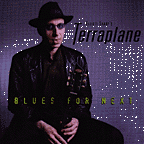 Elliott Sharp's Terraplane / Blues for Next, Knitting Factory Records, KFW-285.
Elliott Sharp's Terraplane / Blues for Next, Knitting Factory Records, KFW-285.
This is one of those non-klezmer albums that get mentioned every so often in these pages because they are soooo worth listening to. I've been on the lookout for new Elliott Sharp material ever since he recorded an awesomely interesting piece on the last Geduldig un Thimann recording. This marries some of his progressive musical sensibility with some screaming good urban blues. In some ways, the music is a continuation of works such as "Alphabet City," but more grounded. The dissonances introduced to traditional blues forms are mild, as such things go. Listening to the first CD (It's a two CD set: "Plus" and "Quartet".) casually, at a distance, one might hear just regular ol' blues of the last decades of the last century. More chances are taken on the "Quartet" CD, but the blues forms still keep things reined in pretty tightly. That said, we're talking good, soulful, dissonant (at last!) blues. It rewards the part of me that always hoped the guys in the San Francisco punk band, Flipper, would learn to play. They might have sounded this good. All in all, not Sharp's usual electronic fare, but excellent, truly excellent, regardless. With Eric Mingus and Dean Bowman on vocals, and Hubert Sumlin on guitar (on the "Plus" disk) things swing, but when he strips down to just the quartet, the album gets more intense, more searcing, less restrained, song, by song. And, to be honest, that's more my kind of blues than Sharp's more familiar electronic stuff. [GRADE: A]
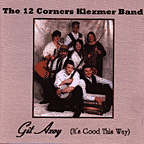 12 Corners Klezmer Band / Git Azoy (It's good this way)
12 Corners Klezmer Band / Git Azoy (It's good this way)
What does a typical, practicing wedding band repertoire sound like these days? I'd say that this release from 12 Corners Klezmer Band represents the breadth quite well. What you don't see, unfortunately, is bandleader Rob Mendel's wife, Roey, doing an amazing job of passing on the dance traditions that go with the music, something she does at camp, and of course, at performances in Rochester, NY. Sticking primarily (on the record at least) to klezmer and Yiddish theatre repertoire, the band does measured, relatively simple versions of everything from the "Sadegurer Khosid" to a Naftule medley. But, of special note is Pete Rushefsky's banjo. Although four members of the band have been regulars at both KlezKamp and KlezKanada, Pete is the person who seems to have absorbed everything there is to know about plucked strings, be they banjos, tsimbls, or anything in between. Having someone of his ability on board doesn't diminish the musicianship of anyone else, but it does provide an extra incentive to listen to this particular album. What this 12 Corners album signifies as much as anything else (listen, for instance, for them stepping into a bluegrass train-rhythm-influenced "Odessa Bulgar") is what music sounds like when played by people who have gotten into klezmer since the revival--these are the kids (spiritually, if not always age-wise) of the original wave of Klezmer Revival musicians, and as good an explanation as any other as to why I don't worry any more about the health of klezmer. Note: 12 Corners retired in 2009 and is no longer available for simkhes. [GRADE: B]
 Klingon Klezmer / Honey would you be meshuge tonight?, (1999?)
Klingon Klezmer / Honey would you be meshuge tonight?, (1999?)
I dunno what is going on in Philadelphia. There's an Intergalactic Jewish Music Festival. There's "Benny and the Vilda Chayas." And there's the Klingon Klezmorim, every bar mitzvah kid's (and their parents) dream. The album blurb claims klezmer music infused with jazz, funk, and dixieland. In practice, there's also a fair helping of chavurah-style nigun, some classical (esp. on "Vienna Freilach") and the occasional reminder of our non-religious Jewish roots as in the Yiddish Socialist "Anti-Fascist March" followed only a couple of songs later by "Zol Shoin Kumen"--the Messiah will come soon. . There's even some shtetl nostalgia! It's all accompanied by some lovely jamming. Yup. It's another klezmer jamband, and another very fun one! More to the point, a damn good band, musically. Damn, I really like this, especially when I need to speak to my dominant personality, the 14-year-old within. [GRADE: A]
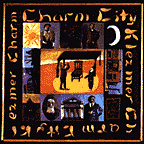 Charm City Klezmer
Charm City Klezmer
In keeping with the theme of the last couple of albums reviewed on this page, here's another "local" band that makes the grade in a big way. In this case, we have an energetic and soulful display of virtuosity running through what is today's ideal sample repertoire: in this case, along with some lovely klezmer music (including a full tilt boogie opening piece written by the year of the album's release by Steve Berson), ranging from a having the good sense to choose a less-well known, excellent Flory Jagoda tune for the obligatory Sephardic number, a couple of great, not overdone Yiddish tunes, including Itsik Manger's "Eynzam" (Lonely). I even forgive them for "Lomir Zikh Iberbetn" which has been overrecorded in the last two years, and which I probably shouldn't hear for a few years until I forget the definitive Flying Bulgars version. Too bad, because I like this version, anyway. This one has nothing to do with God and man, but between two human lovers. Yes, listen to this, make up, and let's go dancing. Indeed! Lively! Energetic! Bonus track included! [GRADE: A]
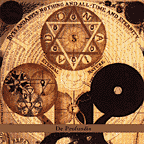 Cracow Klezmer Band / De Profundis, Tzadik TZ7143
Cracow Klezmer Band / De Profundis, Tzadik TZ7143
(Note: as of Jan 2007, this band is known as the Bester Quartet.)
A Polish member of the Jewish-music mailing list first made me hip to this band, whose album makes them sound as though descended from Krakow's new age klezmer art band "Kroke." Then, a few weeks ago, on the WELL, Jane Hirshfield, an amazing poet, but not someone who listens regularly to klezmer music, came back from a poetry event in that city, quite moved by a particular performance, and wrote: "I'm back from Krakow, and though not quite fully caught up yet, wanted to
report that the Gathering of the Poets there was one of the most
extraordinary few days of my life. [The event included] an "art" Klezmer band, if you can imagine such a
thing...." Later, in answer to my query, she confirmed that the band was this one and wrote: "The bass player made his instrument sound like
a plaintive seagull at one point; other times, I could hear the music tilt
into pure jazz; other times again, pure klezmer. The performance was held in
an old Synagogue, so all the men (audience and band alike) wore yamulkas.
"Art" klezmer is the best description I can come up with, lacking any
technical music terms to use--they were stretching the parameters, bending
the tones, the tunes, the references, in ways I could recognize but can't
name. As one friend said, you could see on their faces as well as hear the
times they transcended their own capacities. It was an extraordinary
performance, recognizably sublime. If I knew more, I could convey more, and
I apologize for the limitations of the reporting." [GRADE: A]
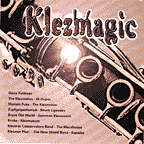 Klezmagic, compilation by MW Records mwcd 10; dist. in US by Hatikvah Music
Klezmagic, compilation by MW Records mwcd 10; dist. in US by Hatikvah Music
I have tended to forget to review anthologies. This is too bad, because there is nothing like a good anthology to give you a chance to hear singers and/or bands that aren't readily available locally, or that aren't familiar, or to establish a mood, or to give to a person who might be interested in Klezmer, but might want to listen to lots of stuff to find out what is right for him or for her. This particular anthology, despite having been compiled a few years ago, is a good example of the better anthology. Released in Europe, and documenting a lovely cross-section of primarily European bands, it also includes popular and less-well-known American artists: the Klezmatics and Klezmer Conservatory Band, and the pioneer Seattle band, the Mazeltones, or New Mexico's "New Shtetl Band. It may be the only anthology to include Giora Feidman and many bands whose members would go a long way not to hear him. There are also singers such as Myriam Fuks and Shura Lipovsky that the average klezmer fan here just doesn't know--to his or her detriment. There is a very generous selection from the Dutch klezmer scene: Di Gojim, Salomon Klezmorim (the abovementioned Fuks), and Klezmokum. There are bands about whom I know nothing: a folky guitar/pennywhistle/contrabass-driven Zupfgeigenhansel (ironically, for people who have read this entire page, their selection is ... "Lomir sich iberbetn"). There are even bands whose Dutch spellings make them look unfamiliar: "Kapelije" turns out to be the band that spells its name in this country, "Kapelye". The only selection that particularly bothers me is a recording from a latter-day version of "The Klezmorim"--the band long after all the original members had left and the remnants took the name to Europe for a while. The album ends with the Polish, Krakowian new-age klezmer sound of "Kroke." Most of the selections are from the late 1980s or early 1990s, making this an especially lovely documentary of the decade in which the klezmer revival came into its own. All in all, an excellent survey of klezmer, with a good range of pleasing songs and something to attract almost everyone. Even me!. [GRADE: A]

